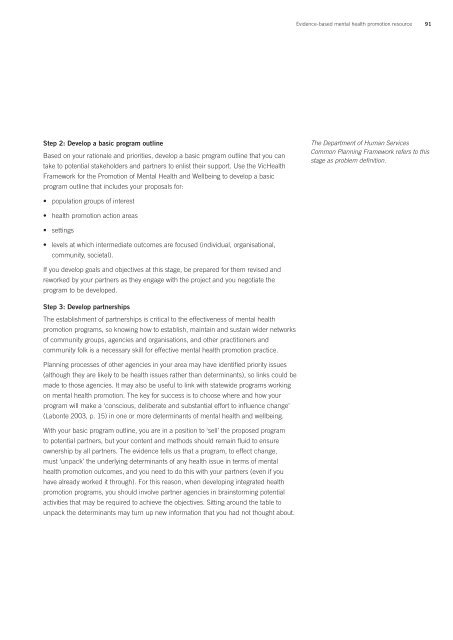Evidence-based mental health promotion resource - health.vic.gov.au
Evidence-based mental health promotion resource - health.vic.gov.au
Evidence-based mental health promotion resource - health.vic.gov.au
You also want an ePaper? Increase the reach of your titles
YUMPU automatically turns print PDFs into web optimized ePapers that Google loves.
<strong>Evidence</strong>-<strong>based</strong> <strong>mental</strong> <strong>health</strong> <strong>promotion</strong> <strong>resource</strong>91Step 2: Develop a basic program outlineBased on your rationale and priorities, develop a basic program outline that you cantake to potential stakeholders and partners to enlist their support. Use the VicHealthFramework for the Promotion of Mental Health and Wellbeing to develop a basicprogram outline that includes your proposals for:The Department of Human Ser<strong>vic</strong>esCommon Planning Framework refers to thisstage as problem definition.• population groups of interest• <strong>health</strong> <strong>promotion</strong> action areas• settings• levels at which intermediate outcomes are focused (individual, organisational,community, societal).If you develop goals and objectives at this stage, be prepared for them revised andreworked by your partners as they engage with the project and you negotiate theprogram to be developed.Step 3: Develop partnershipsThe establishment of partnerships is critical to the effectiveness of <strong>mental</strong> <strong>health</strong><strong>promotion</strong> programs, so knowing how to establish, maintain and sustain wider networksof community groups, agencies and organisations, and other practitioners andcommunity folk is a necessary skill for effective <strong>mental</strong> <strong>health</strong> <strong>promotion</strong> practice.Planning processes of other agencies in your area may have identified priority issues(although they are likely to be <strong>health</strong> issues rather than determinants), so links could bemade to those agencies. It may also be useful to link with statewide programs workingon <strong>mental</strong> <strong>health</strong> <strong>promotion</strong>. The key for success is to choose where and how yourprogram will make a ‘conscious, deliberate and substantial effort to influence change’(Labonte 2003, p. 15) in one or more determinants of <strong>mental</strong> <strong>health</strong> and wellbeing.With your basic program outline, you are in a position to ‘sell’ the proposed programto potential partners, but your content and methods should remain fluid to ensureownership by all partners. The evidence tells us that a program, to effect change,must ‘unpack’ the underlying determinants of any <strong>health</strong> issue in terms of <strong>mental</strong><strong>health</strong> <strong>promotion</strong> outcomes, and you need to do this with your partners (even if youhave already worked it through). For this reason, when developing integrated <strong>health</strong><strong>promotion</strong> programs, you should involve partner agencies in brainstorming potentialactivities that may be required to achieve the objectives. Sitting around the table tounpack the determinants may turn up new information that you had not thought about.



